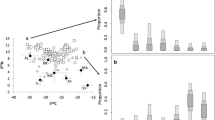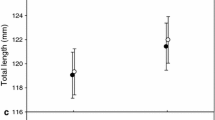Abstract
Predator-prey interactions among size-structured populations may be strongly influenced by factors which affect growth rates of prey. I examined the importance of prey growth in the interaction between large-mouth bass (Micropterus salmoides) and their prey, bluegill (Lepomis macrochirus), by analyzing diets and growth rates of bass in a set of seven lakes in south-central Wisconsin. Sizes of bluegill consumed by bass changed dramatically across a gradient of bluegill growth, which resulted in differing patterns of bass growth. In lakes with slow bluegill growth, small bass fed on the youngest bluegill cohort, but large bass were capable of feeding on several age classes. Consequently, bass growth rates were strongly size-dependent; small bass ate small prey and had low growth, but growth rates increased substantially with size as bass ate progressively larger prey. When bluegill had high growth rates, they quickly reached a size refuge from predation and bass of all sizes were restricted to feeding on the youngest/smallest prey. In these lakes, bass growth rates were more uniform across bass sizes. Because growth rates influence population size-distributions, variation in bluegill growth can have strong effects on the structure of bass populations. These effects could potentially feed back to further influence the interaction between predator and prey.
Similar content being viewed by others
References
Adams SM, DeAngelis DL (1987) Indirect effects of early bass-shad interactions on predator population structure and food web dynamics. In: Kerfoot WC, Sih A (eds) Predation: direct and indirect effects on aquatic communities. University Press of New England. Hanover pp 103–117
Applegate RL, Mullen JW (1966) Food of young largemouth bass (Micropterus salmoides in a new and old reservoir. Trans Am Fish Soc 96:75–77
Bagenal TB (1978) Aspects of fish fecundity. In: Gerking SD (ed) Ecology of freshwater fish production. Wiley, New York, pp 75–101
Belk MC, Hales LS (1993) Predation induced differences in growth and reproduction of bluegills (Lepomis macrochirus). Copeia 1993:1034–1044
Carlander KD (1982) Standard intercepts for calculating lengths from scale measurements for some centrarchid and percid fishes. Trans Am Fish Soc 111:332–336
Cochran PA, Adelman IR (1982) Seasonal aspects of daily ration and diet of largemouth bass, Micropterus salmoides, with an evaluation of gastric evacuation rates. Environ Biol Fish 7:265–275
Dillard JG, Novinger GD (1975) Stocking largemouth bass in small impoundments. In: Stroud RH, Clepper H (eds) Black bass biology and management. Sport Fishing Institute, Washington, pp 459–479
Giles N (1980) A stomach sampler for use on live fish. J Fish Biol 17:411–429
Gotthard K, Nylin S, Wiklund C (1994) Adaptive variation in growth rate: life history costs and consequences in the speckled wood butterfly Pararge aegeria. Oecologia 99:281–289
Hambright KD (1991) Experimental analysis of prey selection by largemouth bass: role of predator mouth width and prey body depth. Trans Am Fish Soc 120:501–508
Heidinger RC (1975) Life history of the largemouth bass. In: Stroud RH, Clepper H (eds) Black bass biology and management. Sport Fishing Institute. Washington, pp 11–20
Hoyle JA, Keast A (1987) The effect of prey morphology and size on handling time in a piscivore, the largemouth bass (Micropterus salmoides) Can J Zool 65:1972–1977
Keast A, Eadie JM (1985) Growth depensation in year-0 largemouth bass: the influence of diet. Trans Am Fish Soc 114:204–213
Kurzava LM, Morin PJ (1994) Consequences and causes of geographic variation in the body size of a keystone predator, Notophthalmus viridescens. Oecologia 99:271–280
Lawrence JM (1958) Estimated sizes of various forage fishes largemouth bass can swallow. Proc Ann Conf SE Assoc Game Fish Comm 11:220–225
Luecke C, Rice JA, Crowder LB, Yeo SF, Binkowski FP (1990) Recruitment mechanisms of bloater in Lake Michigan: an analysis of the predatory gauntlet. Can J Fish Aquat Sci 47:524–532
Miller TJ, Crowder LB, Rice JA, Marschall EA (1988) Larval size and recruitment mechanisms in fishes: toward a conceptual framework. Can J Fish Aquat Sci 45:1657–1670
Mittelbach GG (1981) Foraging efficiency and body size: a study of optimal diet and habitat use by bluegills. Ecology 62:1370–1386
Mittelbach GG (1988) Competition among refuging sunfishes and effects of fish density on littoral zone invertebrates. Ecology 69:614–623
Moore MV (1988) Differential use of food resources by the instars of Chaoborus punctipennis. Freshwater Biol 19:249–268
Olson MH (1996) Ontogenetic niche shifts in largemouth bass: variability and consequences for first year growth. Ecology 77:179–190
Olson MH, Mittelbach GG, Osenberg CW (1995) Competition between predator and prey: resource-based mechanisms and implications for stage-structured dynamics. Ecology 76:1758–1771
Osenberg CW, Mittelbach GG (1989) Effects of body size on the predator-prey interaction between pumpkinseed sunfish and gastropods. Ecol Monogr 59:405–432
Osenberg CW, Olson MH, Mittelbach GG (1994) Stage-structure in fishes: resource productivity and competition gradients. In: Stouder DJ, Fresh KL, Feller RJ (eds) Theory and application in fish feeding ecology. University of South Carolina Press, Columbia, pp 151–170
Osenberg CW, Werner EE, Mittelbach GG, Hall DJ (1988) Patterns of growth in bluegill (Lepomis macrochirus) and pumpkinseed (Lepomis gibbosus) sunfish: environmental variation and the importance of ontogenetic niche shifts. Can J Fish Aquat Sci 45:17–26
Paine RT (1976) Size-limited predation: an observational and experimental approach with the Mytilus-Pisaster interaction. Ecology 57:858–873
Paszkowski CA, Tonn WM (1994) Effects of prey size, abundance, and population structure on piscivory by yellow perch. Trans Am Fish Soc 123:855–865
Persson L (1985) Asymmetric competition: are larger animals competitively superior? Am Nat 126:261–266
Persson L (1988) Assymetries in competitive and predatory interactions in fish populations. In: Ebenman B, Persson L (eds) Size-structured populations: ecology and evolution. Springer, Berlin Heidelberg New York, pp 203–218
Persson L, Eklov P (1995) Prey refuges affecting interactions between piscivorous perch and juvenile perch and roach. Ecology 76:70–81
Phillips JM, Jackson JR, Noble RL (1995) Hatching date influence on age-specific diet and growth of age-0 largemouth bass. Trans Am Fish Soc 124:370–379
Polis GA, Myers CA, Holt RD (1989) The ecology and evolution of intraguild predation: potential competitors that eat each other. Annu Rev Ecol Syst 20:297–330
Rice JA, Crowder LB, Rose KA (1993a) Interactions between size-structured predator and prey populations. Trans Am Fish Soc 122:481–491
Rice JA, Miller TJ, Rose KA, Crowder LB, Marschall EA, Trebitz AS, DeAngelis DL (1993b) Growth rate variation and larval survival: inferences from an individual based size-dependent predation model. Can J Fish Aquat Sci 50:133–142
Seaburg KG (1957) A stomach sampler for live fish. Prog Fish Cult 19:137–139
Sih A, Crowley P, McPeek M, Petranka J, Strohmeier K (1985) Predation, competition, and prey communities: a review of field experiments. Annu Rev Ecol Syst 16:269–311
Summerfelt RC (1975) Relationship between weather and yearclass strength of largemouth bass. In: Stroud RH, Clepper H (eds) Black bass biology and management. Sport Fishing Institute, Washington, pp 166–174
Swingle HS, Smith EV (1940) Experiments on the stocking of fish ponds. Trans N Am Wild Conf 5:267–276
Tesch FW (1968) Age and growth. In: Ricker WE (ed) Methods for assessment of fish production in fresh waters. Blackwell, New York, pp 93–123
Timmons TJ, Shelton WJ, Davies WD (1980) Differential growth of largemouth bass in West Point Reservoir, Alabama-Georgia. Trans Am Fish Soc 109:176–186
Tonn WM, Paszkowski CA (1986) Size-limited predation, winterkill, and the organization of Umbra-Perca assemblages. Can J Fish Aquat Sci 43:194–202
Travis J (1980) Genetic variation for larval specific growth rate in the frog Hyla gratiosa. Growth 44:167–181
Travis J, Keen WH, Julianna J (1985) The role of relative body size in a predator-prey relationship between dragonfly naiads and larval anurans. Oikos 45:59–65
Werner EE (1977) Species packing and niche complimentarity in three sunfishes. Am Nat 111:553–578
Werner EE (1986) Species interactions in freshwater fish communities. In: Diamond J, Case TJ (eds) Community ecology. Harper and Row, New York, pp 344–358
Werner EE, Gilliam JF (1984) The ontogenetic niche and species interactions in size-structured populations. Annu Rev Ecol Syst 15:393–425
Wilbur HM (1972) Competition, predation, and the structure of the Ambystoma-Rana sylvatica community. Ecology 53:3–21
Wilbur HM (1988) Interactions between growing predators and growing prey. In: Ebenman B, Persson L (eds) Size=structured populations: ecology and evolution. Springer, Berlin Heidelberg New York, pp 157–172
Wissinger SA (1992) Niche overlap and the potential for competition and intraguild predation between size-structured populations. Ecology 73:1431–1444
Zaret TM (1980) Predation and freshwater communities. Yale University Press, New Haven
Author information
Authors and Affiliations
Rights and permissions
About this article
Cite this article
Olson, M.H. Predator-prey interactions in size-structured fish communities: implications of prey growth. Oecologia 108, 757–763 (1996). https://doi.org/10.1007/BF00329052
Received:
Accepted:
Issue Date:
DOI: https://doi.org/10.1007/BF00329052




